Hello and welcome to The Compost Bin. I'm Compostwoman and I live with my family in rural Herefordshire. We have nearly four acres of garden and woodland, all managed organically and to Permaculture principles, which we share with Chickens, Cats and assorted wildlife. We also grow a lot of our own food, run courses in all sorts of things and make a lot of compost!
I am a Master Composter and have spent more than a decade as a volunteer Community Compost adviser with Garden Organic and my local Council.
I'm a self employed Environmental Educator so I run workshops and events where I talk about compost, veg growing, chicken keeping, cooking, preserving and sustainable living. I also run crafts workshops and Forest School/outdoor play sessions in our wood.
We try to live a more self sufficient lifestyle here, as best we can, while still having a comfortable life and lots of fun.
To learn more about us click on the About Compostwoman tab and remember to click on the photos to make them full size!
Tuesday, 6 December 2016
Childhood memories of washing lines
My family moved to a very rural smallholding in 1969, no mains water, electric, oil or gas, oil lamps, candles, wood range for cooking, a well for all water, chamber pots inside and a pit privy at the bottom of the garden, the building covering it which was moved once a year to a new location, with copper and dolly and mangle for washing, and a tin bath which we all shared once a week and a kitchen garden, a larder, a cold shelf ( no fridge!) and killing and gutting game, chickens etc. My poor mum spent 2 years living like this!
She even made beer in the copper wash kettle! (real Lark Rise to Candleford stuff, and my Mum actually lived in that area in the 1920's! - I was born in 1962 when she was in her late 40's btw) and we had bees and pigs and chickens and rabbits and ducks and geese and sheep and goats and horses and a milk cow.
No electricity for the first 6 months we lived there... so we had tilley lamps and candles for lighting and an iron heated on the range.
I helped with all this and can remember the effort involved even now, nearly 50 years on (I was 7 at the time) helping Mum with the washing and the cooking and the getting water from the well.
I remember washing as an absolute MISERY in the winter. Trying to get clothes, especially sheets and towels, dry was terrible, and the house wreathed in stream, and the pages of my Christmas present book getting damp ( it was the Lion, the Witch and the Wardrobe as I recall!)
BUT it was also magical and the first winter we were there, it was the BEST Christmas I can ever remember, which is why I can STILL remember it so vividly I guess :-)
Hard to imagine now, living like that, within a middle aged person's lifetime (me)...but we did, until 1971 when we finally got the new kitchen and bedrooms and bathroom built, then it was radiators and electric cookers and 'fridges etc, (although my Mum always said nothing she cooked ever tasted quite as good, compared with what she had done on that old range)
I also had horses and we had chickens and pigs and sheep, .and I used one of those LETHAL chaff cutters to make food for them, omg child protection laws would have a field day over that now! Whirling, unprotected blades being operated by an 8 year old! The Mangel Worzel cutter was almost as dangerous!
Actually, it WAS ALL dangerous, not all the old stuff is good!
But I do look back on it with immense pleasure, not least because I KNOW I could do it all again ITSHTF (!)
Funny what memories small domestic tasks can trigger :)
Thursday, 24 November 2016
Looking back through the blog - 20 years of Compost Mansions #1
[ We have lived in Compost Mansions for 20 years in 2017. So I have been looking back at all the things we have done here, since we moved in. ]
Looking back through the blog, as I do, sometimes, and I realized this time in 2010 I was packing up and clearing out our sitting room ready for Compostman to start the huge refurbishment. the sitting room is the very heart of our house, with the woodburner, books crafts table and chair, music and tv so it was a huge job!We then spent the next 12 months squashed into a room less than half the size. but it was worth it in the end.
 |
| Clearing out our sitting room so it can be gutted and insulated and all sorts of stuff done to it by lovely Compostman |
Monday, 31 October 2016
Halloween/Samhain
I have walked in the wood today and watched the leaves as they came whirling down, broken free from the tree by the wind to land on the ground and slowly return to the soil.
I caught a leaf as it fell through a shaft of sunlight and made a wish.
I spent today outside, tending to my plants and animals and family, weaving the threads of love and nurturing around them all to make them comfortable and secure.
I shall sit by the fire tonight, with candles lit, and think of all my loved ones, my friends and family, animal and people. Those I still see in life and those who have gone on before me.
Thursday, 20 October 2016
Making chutney
Wikipedia ( always useful) describes Chutney as
a term for a variety of sweet and spicy condiments, usually involving a fresh, chopped primary vegetable or fruit with added seasonings. Chutney, as a genre, is often similar to the Pakistani pickle and the salsa of Latin American cuisine, or European relish.So...a tradition of chutney making, hmmm? well the tradition is alive and well at Compost Mansions, that's for sure! I love making Chutney, I usually make 4 or 5 different batches in the autumn and winter, from fresh. glut fruit and veg and then later from stored apples and frozen fruit and veg. I then have lots of jars stored, to give as gifts, to barter for other foods or services and, of course, to eat! I am talking, of course, about the sort which is preserved by having lots of vinegar and sugar in it, potted whilst hot, into warm jars so a vacuum forms when the contents cool and then kept in a sealed jar until ready to eat
Chutney may be dry or wet; dry chutney is generally in the form of powder. In India, a chutney is often made to be eaten fresh, using whichever strongly-flavored ingredients are locally available at the time. It would not normally contain preserving agents, since it is intended to be consumed quickly after preparation. The Hindi translation of "to make chutney" is a common idiom meaning "to crush". This is because the process of making chutney often involves the crushing the ingredients together.[citation needed]
The use of a stone mortar and pestle is often regarded as vital to create the ideal chutney. It consists of a small stone bowl (called a "kharal" or "khal" in Hindi, Tamil kal கல்), or a flat piece of stone (called a "sil") on which the ingredients are crushed together with a rounded stick of stone or wood (called a "batta", pronounced with a hard 't').
Chutney is more familiar in North America and Europe in a form that can be stored. To this end, vegetable oil, vinegar, or lemon juice are used to enhance the keeping properties.
Beginning in the 1600 chutneys were shipped to European countries like England and France as luxury goods. Western imitations were called "mangoed" fruits or vegetables. In the nineteenth century, brands of chutney like Major Grey's or Bengal Club created for Western tastes were shipped to Europe.
Generally these chutneys are fruit, vinegar and sugar cooked down to a reduction.
The tradition of chutney making spread throughout the British empire, especially in the Caribbean and American South where chutney is still a popular condiment for ham, pork and fish.
I made Apple and Courgette chutney back in September, as I had a lot of Apples and Courgettes to hand
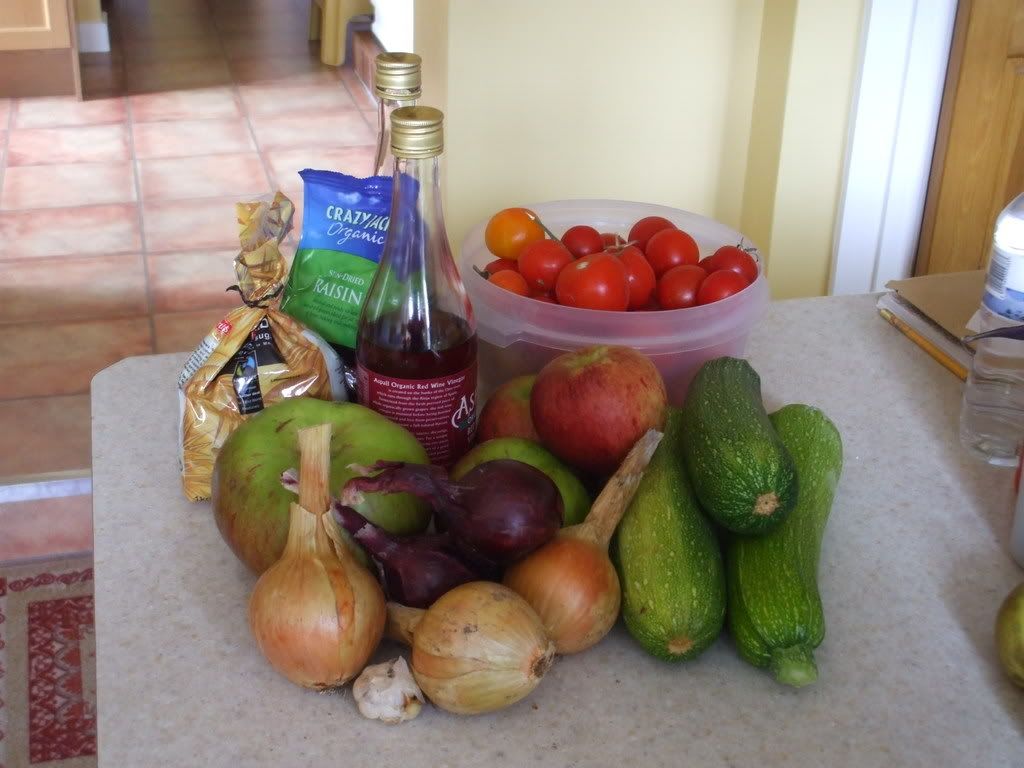
Recipe
1 Kg cored, peeled , diced Apples (Bramley)
1 Kg peeled, diced Courgette
0.5 Kg diced Onion
Some Garlic ( I used about 6 small cloves...and they WERE small!)
0.5 Kg skinned chopped Tomatoes
0.5 Kg chopped Raisins and Sultanas mixed
0.5 Kg Light brown Sugar
0.6 L Cider Vinegar( I actually used a mixture of Cider and Red Wine)
20g Salt
1 tsp Paprika
1/2 tsp Ground Ginger
Black Pepper ( I just grind it into the pan...I used lots)
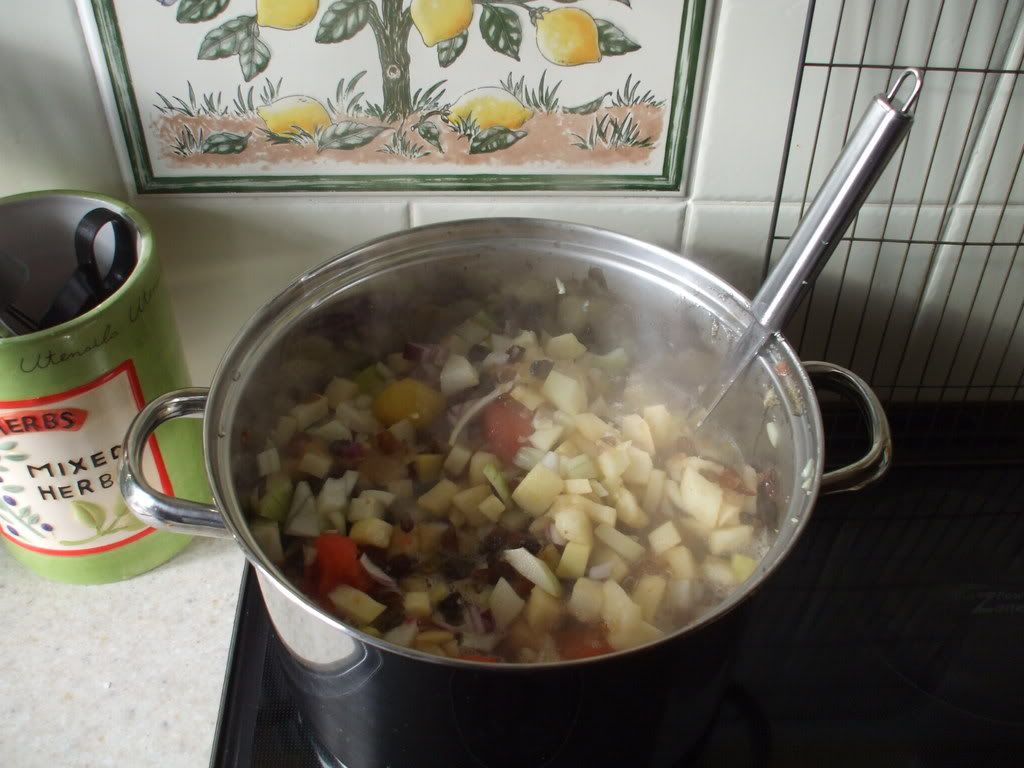
Prepare everything by finely chopping (if you use a machine be careful not to mince too fine or the chutney will be a little mushy), put it in a large Stainless Steel pan, bring to boil, reduce heat to low simmer, leave.
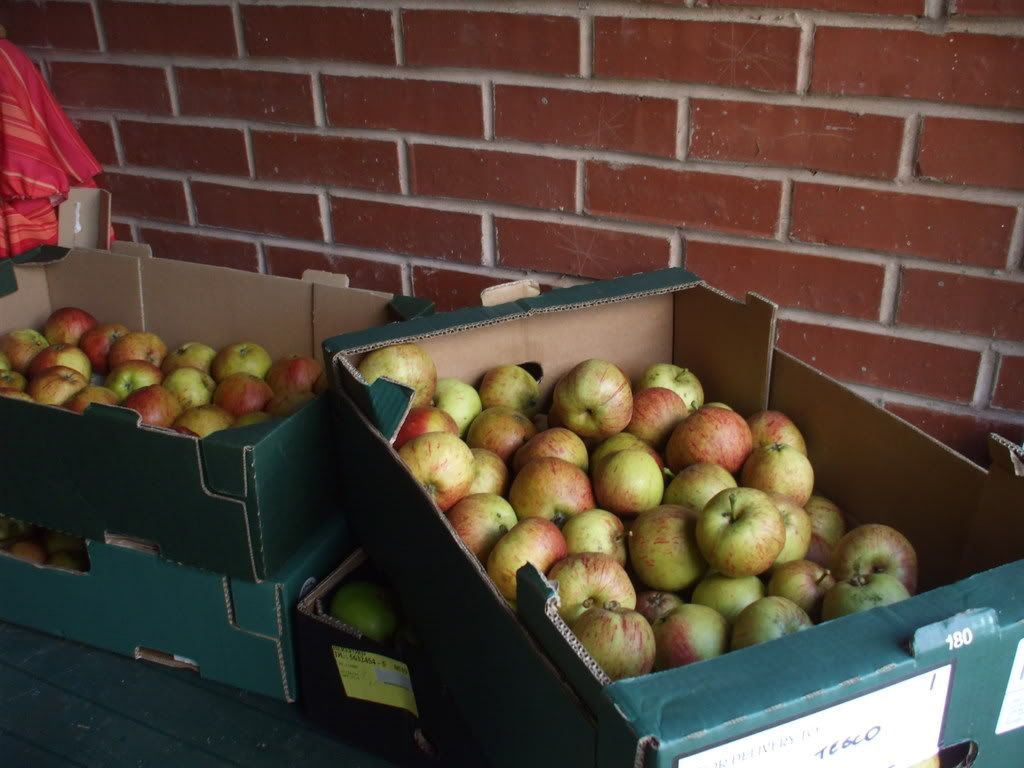
and go and grade apples for storing, clean out hens, drink tea, etc etc....
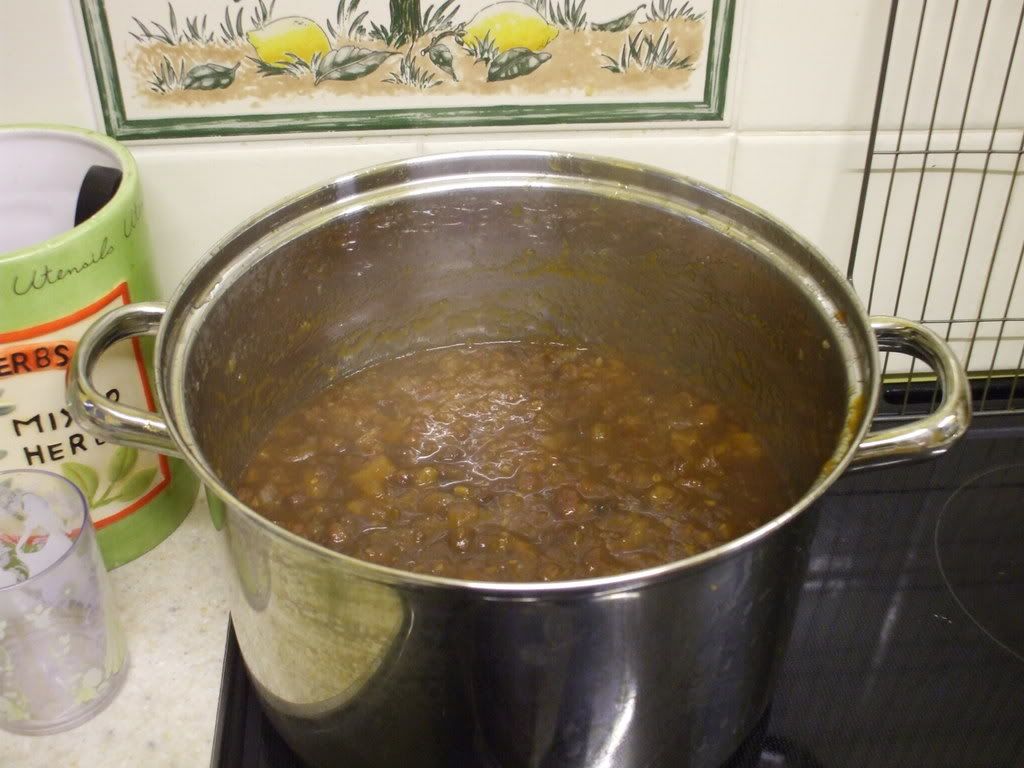
return now and then to give a stir with a wooden or stainless spoon. About 4 hours later (it may take less time , I find it depends on the size of the base of your pan!) keep a close eye on it to see if it is nearly ready to pot.
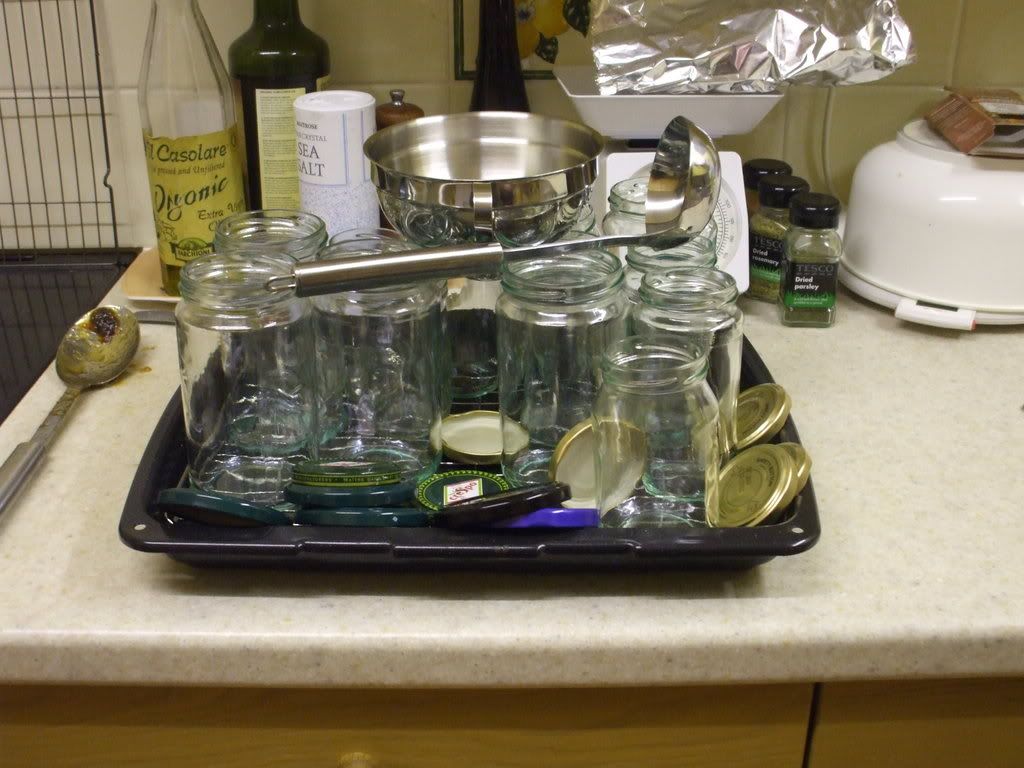 Take about 10 washed jars
Take about 10 washed jars(350g ish) and lids ( which MUST be vinegar proof! so use old pickles jars for preference!) and put in the oven on a rack ( I use the toaster tray which came with the oven as the jars don't fall off it so easily.
I use recycled jars, as I am not selling my produce. If you want to sell it you need to use new lids (in the UK) and standard sized jars.
EDITED by Compostwoman later for clarity to add
I only tend to re-use the lids once and check the seal VERY carefully each time...and with the button lids it is obvious if the seal has failed......if in doubt get new lids!
glass jars are, of course, virtually endlessly reusable if not damaged...
Heat jars at 120C ish for about 10 mins then turn down oven to 80C until you are nearly ready to pot the chutney, then turn off the oven and allow the residual heat to keep the jars hot ( saves energy!) Try to time this phase so as to coincide with the end of doing the Sunday Roast or some baking....I try but usually fail a bit miserably here!....)
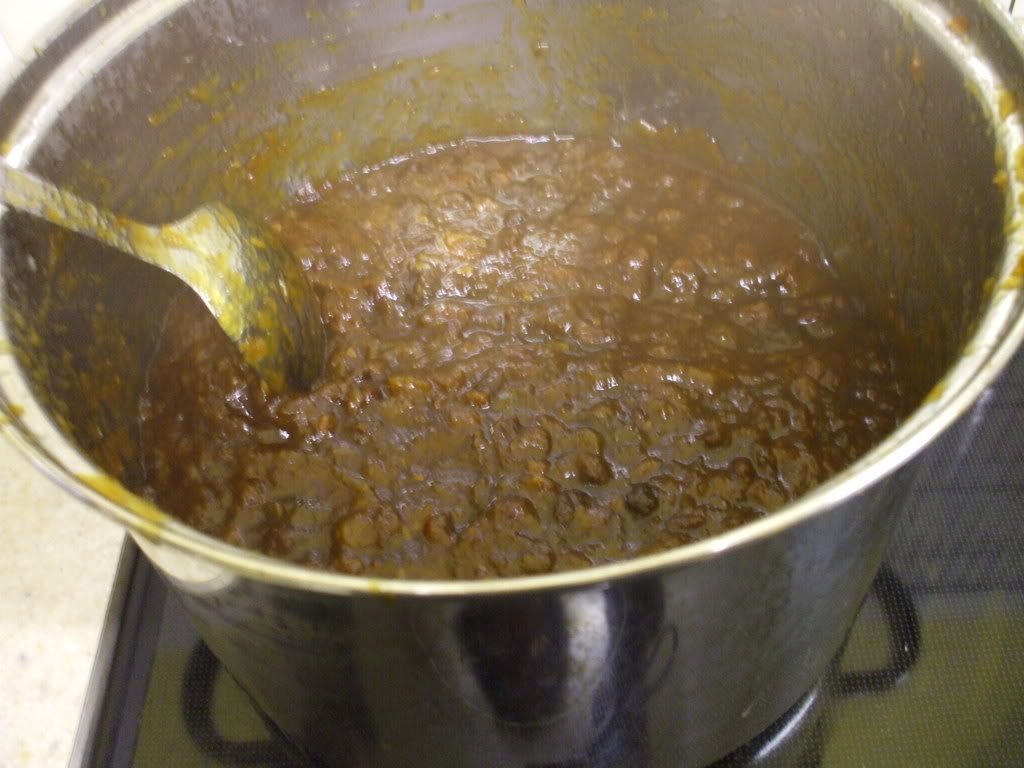
When you think the chutney is nearly done do the "channel" test...draw a spoon through the surface of the chutney, if a channel appears its done. If not, keep simmering for another few mins and test again.
When done, turn off the heat and let the residual heat in the ring ( if electric) finish the simmer (saves energy, but won't work with Gas)
Fill hot jars to almost full, wipe clean, put on lids and screw on tight. Watch out as the jars WILL be hot! I have a stainless jam funnel and a stainless ladle...we got these to make life easier as we make a LOT of jam and chutney! Don't worry if you don't have these, use a Pyrex jug...make sure it is clean and sterilised...and watch out for the hot handle!!
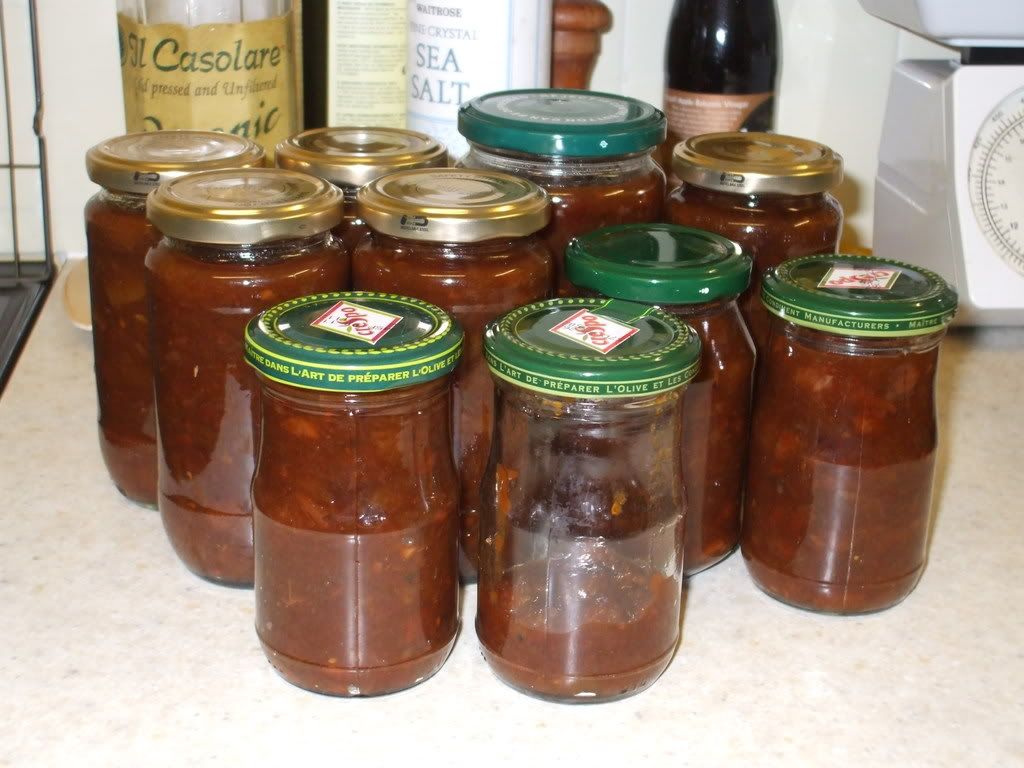
Admire your handiwork, make sure the vacuum "buttons" have pulled down on the lids, if your lids had them, then when cool, LABEL(!) PUT AWAY in a cool dark place to mature for AT LEAST 2months...
Seriously, it WILL taste nicer if you leave it to mature!
I work from an all purpose recipe which I adapt and vary depending on the fruits, vegetables, spices etc. available, and on my mood!
My chutney recipes are basically 600 ml vinegar, 20 g salt, 500 g sugar, assorted spices usually around 2 teaspoons of them (I use ground spices quite happily!),500 g onions and then another 3 Kg of assorted fruit and veg. This makes around 10"chutney/relish" sized jars, the 350 g ones.
I find SOME fruit is needed, even if its only 500 g apples and 500g dried fruit, as apples especially help to thicken the chutney, they and the dried fruit is part of the 3 Kg of assorted stuff though! I also always use Cider vinegar or wine vinegar occasionally, I use Aspalls Organic cider vinegar ( for those in the UK) and find it makes for a smooth result without a harsh vinegary tang...it IS possible to eat my chutney immediately but I would recommend keeping it for at least 2 months, longer if you can!
So, that's how I make chutney. I hope this post has been useful to you and if you don't make chutney at the moment, it will inspire you to have a go. There is nothing to beat home made chutney to liven up a cheese sandwich, or a plate of salads or to add to a curry! And, of course you know what has gone into it and you have saved yourself some money and earned the satisfaction of doing something for yourself.
Tuesday, 4 October 2016
Making Damson Vodka
So I thought I would tell you, again :)
Take a clean jar, I used a Le Parfait jar, but any wide necked jar will do.
Put in washed, pricked fresh fruit and add spirit of choice. I have found Vodka or brandy to be good - it doesn't have to be an expensive brand.
If you don't want to have to prick the fruit, freeze the fruit whole, then put it in the jar and pour on the spirit. The liquid will rapidly cause the fruit to split.
Add sugar. It is better to add too little as you can always add more, if you want it sweeter when you taste test it!
Put the jar somewhere you can shake/upend until all the sugar has dissolved.
Put away in a cool, dark place.
Leave for up to a year...I have found if you leave it longer than that it might get a slightly musty taste.On the other hand it might become divine and utterly delish! So it is up to you to keep on tasting the jar occasionally!
Strain (I use one of those permanent coffer filters for this inside a funnel, all sterilised) into a suitable bottle ( I save the small wine bottles one can get (25 or 35 cl) is these are ideal to give as gifts as well!)

Label.
Drink!

Damsons in Vodka and sugar

After a day of shaking/soaking

